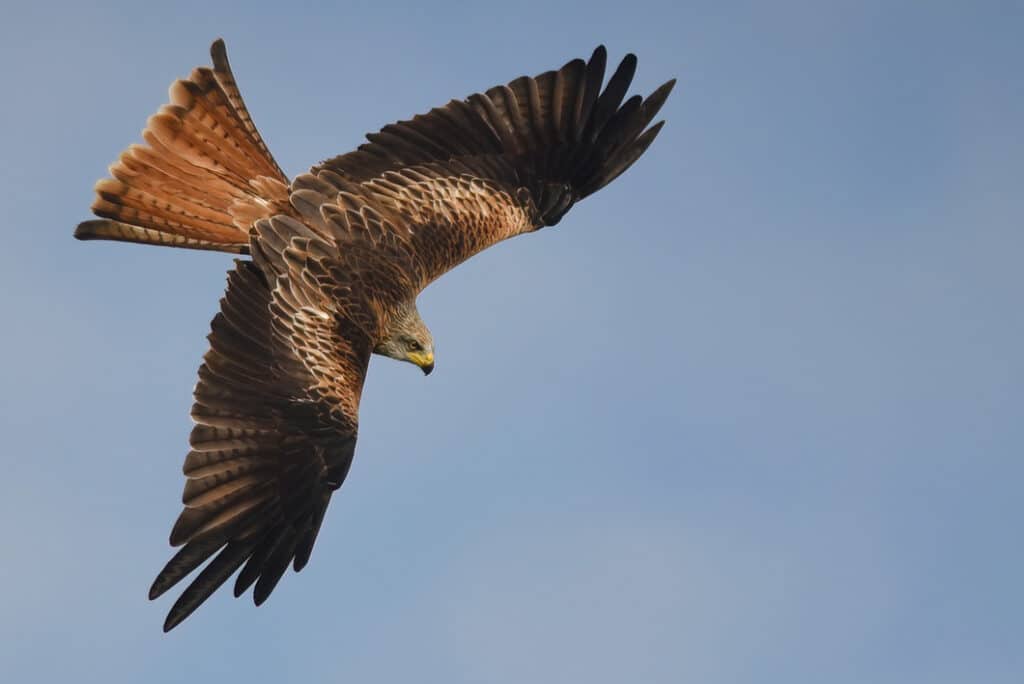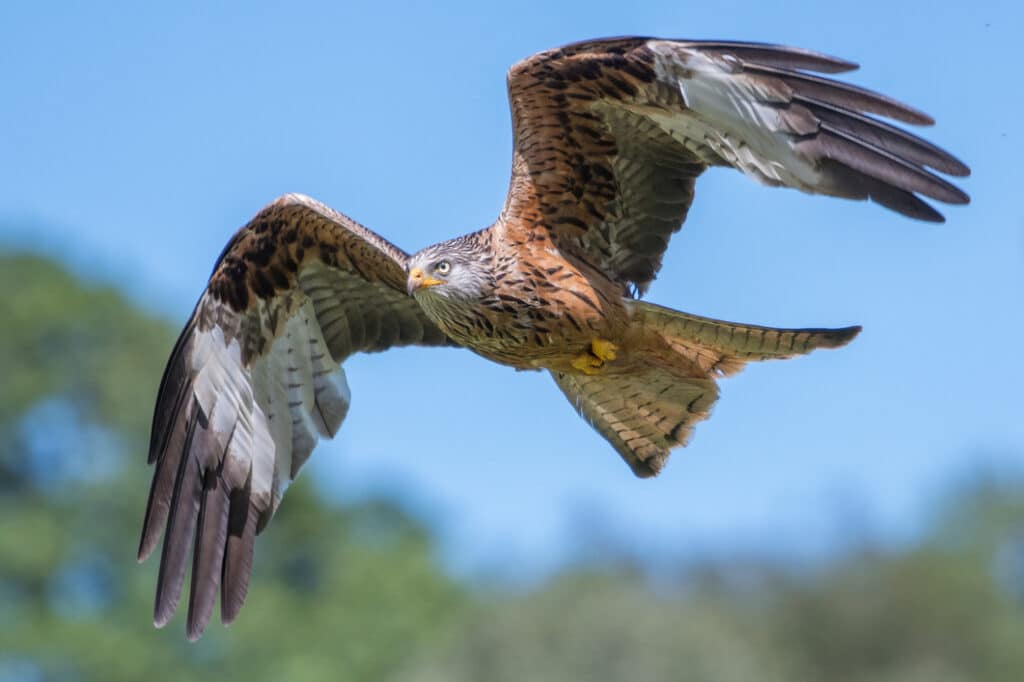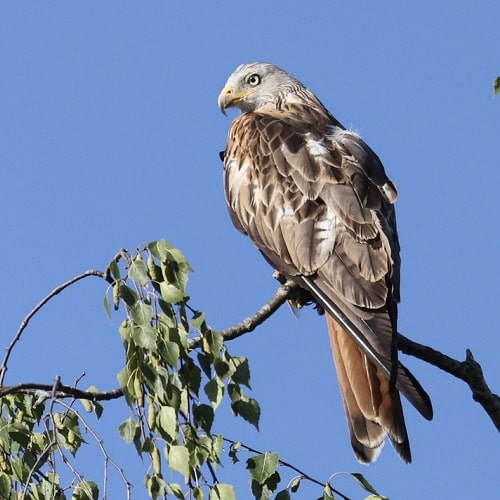Facts about the
Red Kite
Scientific name: Milvus milvus
Bird Family: Kites, hawks and eagles
UK conservation status: Green
At a glance
Compared with Common Buzzard, when soaring has a forked (rather than rounded) tail and flat (not raised) wings.
Once confined to Wales, reintroductions of this beautiful bird of prey have seen numbers rebound spectacularly.
While still recovering lost populations, some shooting estates say there are now ‘too many’ kites.
With its reddish-brown body, deeply forked tail, and effortlessly graceful flight the Red Kite is one of the most recognizable birds of prey in Britain. Almost entirely confined to Europe (with possibly a few pairs still in Morocco), they occupy a mosaic of different habitats including mature deciduous and mixed forests, forest edges, clearings, meadows, cultivated fields, pastures, Mediterranean bush, farmland, scrub habitat, wetlands, and olive tree plantations.
Fairly weak hunters in comparison with other raptors, Red Kites are scavengers and typically feed on dead animals and road kill, though they have been seen to take animals such as mice, voles, rabbits, crows and pigeons. They also eat invertebrates such as beetles and earthworms, especially in Spring.


For a bird that is widespread and generally fairly unfussy about what it eats, an enormous amount of conservation work has had to take place to avoid the species’ extinction. Persecuted for centuries, suffering from secondary poisoning from pesticides, and impacted by huge habitat change across Europe, populations have crashed in many areas.
Several European countries have launched programmes to build up numbers of Red Kite, many of which include captive breeding and release efforts. One of the longest-running has been here in the UK, where the Red Kite was once a very familiar bird. During the Middle Ages kites helped keep the streets clean and was protected by a royal decree. However, by the 16th century and the advent of hunting estates, a bounty was placed on its head and, in common with many other birds of prey, it was relentlessly persecuted as ‘vermin’.

The persecution continued through the following centuries largely by game keepers, who typically (and wrongly) accused a carrion-eating species of taking ‘game’. As it became rarer, Red Kites became a target for taxidermists and egg collectors. By 1871 the Red Kite was extinct in England and in Scotland by 1879. By 1903, when protection efforts started, just a handful of pairs were left in remote parts of central Wales.
Up until the 1990s if you wanted see breeding Red Kites in Britain, you headed for Tregaron (remarkably the population that hung on there was – genetic studies have discovered – descended from a single female). Very gradually the Welsh birds began to increase and spread, but conservation bodies realised that without help the species might never start breeding in England or Scotland again.
Red Kites have now also been brought from Sweden and Germany to North and Central Scotland, and breeding populations have been successfully established. Red Kites were translocated from the burgeoning Chilterns population to Dumfries & Galloway, where breeding is now regular.
Red Kites have rebounded so spectacularly that feeding centres at, for example, Gigrin Farm where kites are fed every day at 3pm, attract hundreds providing a natural spectacle that would have been unthinkable just a few decades ago.

In fact, so successful has breeding been in the UK now (the BTO puts the population at over 4000 pairs and they are still expanding into unoccupied areas), that young Red Kites have now been sent to Spain, where the birds that kickstarted the UK’s reintroduction efforts originated. In mid-2022, fifteen young Red Kites were flown to Madrid to be released in Extremadura and Andalusia.
So is everyone happy to see this beautiful bird back in our skies? Of course not. While some shooting estates have finally admitted that Red Kites are not ‘vermin’, others have started the wearisome and inaccurate ‘too many Red Kites’ narrative that conservationists and raptor workers are all too familiar with.
The RSPB (normally fairly cautious when it comes to outright accusations) says that poisoning is still a major problem in northern Scotland, limiting the expansion of Red Kites there. A 2010 study found that 40% of the 103 Red Kites found dead between 1989 and 2006 were killed through poisoning. In a number of cases, radio tags attached to kites for research purposes were deliberately removed. In 2014, twelve Red Kites and five buzzards were all found poisoned within a two-square-mile area on the Black Isle, north of Inverness, at the core of the kites breeding area. Police dropped their investigation three years later and no-one has ever been charged.
In 2015 RSPB Scotland published a report highlighting the persecution of all birds of prey in Scotland between 1994 and 2014. Almost 800 protected raptors had been illegally killed, including 104 Red Kites, 37 Golden Eagles, 30 Hen Harriers, 16 goshawks and 10 White-tailed Eagles. They said their review showed most illegal killings took place in areas associated with shooting – especially areas intensively managed for driven grouse shooting.
Amongst numerous examples of illegal persecution of Red Kites:
- A 2016 report in the Northern Echo reported concerns were “growing for the region’s Red Kite population after another of the birds was shot in North Yorkshire – the tenth to die in the past two months”.
- IN 2017 Red Kite ‘Black 5W’, was found dead with gunshot wounds in County Down. He was born just three months earlier at a nest site near Downpatrick.
- In 2020 three Red Kites were shot and killed in a ‘horrific’ attack near Newtown (mid-Wales).
- A Red Kite was killed in an illegal trap on an unnamed Berkshire pheasant-shooting estate.
- A Red Kite was found shot and killed near Leeds.
- A poisoned Red Kite was found on the Moy Estate (near Cairngorms National Park) – which partly led to the estate having its General Licence removed in 2022.
- A Red Kite was found shot in Cirencester near one of Gloucestershire’s largest pheasant shoots.
- In 2022 Wiltshire gamekeeper Archie Watson was sentenced after dumping the body of a shot buzzard into a covered well that was later found to contain eleven buzzards and four Red Kites.
- In December 2022 Raptor Persecution UK reported that Police Scotland had only just released news of a young Red Kite found poisoned on a grouse moor (Dava Moor) in May 2021: no further details were released.
- In March 2023 Police Scotland appealed for information after a witness reported a Red Kite being shot on a grouse moor estate near Grantown-on-Spey.
- In March 2023 a Red Kite was found shot and dying on a grouse moor in Co Durham.
- The body of a Red Kite was found near North Creake in Norfolk in August 2023: tests proved it had ingested bendiocarb.
- Vivienne, a well-known individual because of her pale plumage, was shot in Co. Newry in April 2024. She was later euthanised by the vet treating her.
- In November 2024 the RSPB released news that a Red Kite had been found poisoned with carbofuran near Dornoch in East Sutherland.
- In June 2025 a Red Kite was found poisoned in Perthshire. Toxicology tests found an unnamed rodenticide and the banned pesticide Aldicarb.
